Having a clean sanded is a distant dream of every fish hobbyist. Fortunately, nature offers a fantastic creature known as “Sand sifting goby” to help saltwater aquarists. Let’s look at more exciting facts about them.
Introduction
Jump To
- 1 Introduction
- 2 One Look Care Guide
- 3 Sand Sifting Goby Appearance
- 4 Sand Sifting Goby Types
- 5 How do Big Sand-Sifting Gobies get?
- 6 The Behavior of Sand Sifting Goby
- 7 Is Sand Sifting Goby Aggressive?
- 8 Do Sand Sifting Gobies Bite?
- 9 Sand Sifting Goby Lifespan
- 10 Sand Sifting Goby Care in Aquariums
- 11 Sand Sifting Goby Breeding
- 12 How To Feed Sand Sifting Goby?
- 13 Tankmates for sand sifting goby in an aquarium?
- 14 Will Sand Sifting Gobies Eat Cleaner Shrimp?
- 15 Sand Sifting Goby Predators
- 16 Sand Sifting Goby Facts
- 17 Related Questions
- 18 Source
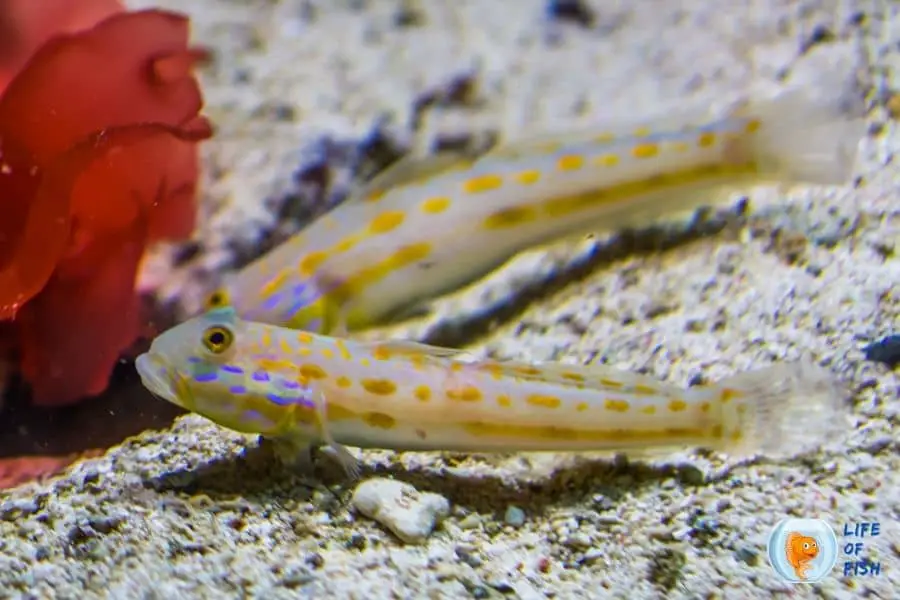
They are an amazing saltwater fish that is mainly associated with the bottom water column. Most saltwater aquarists love to rear them because of their fabulous body color patterns and unique behavior. They stir the sand bed of your tank and search for food. Moreover, they take sands to their mouth and release them out from their gills. While doing this, they grab some food particles that hide in the sand.
They also sift and dig sand substrate and lie on it. Their behavior helps keep your tank substrate free from food particles and other organic debris. Additionally, they help to aerate the tank sandbed. Also, it prevents food deterioration and toxic gas production in the tank. There are several types of Sand sifting gobies found in the ocean. Among them, “Diamond Goby” is the most popular fish because they perform well in captivity.
Also, Goby fish rarely show aggression towards other fish varieties. Sometimes they may exhibit aggressive behaviors to the same species of gobies too. Thus, kept single or mated pairs together. Their caring is easy. Since they are hardy fish that can resist many diseases, it makes them an ideal choice for beginner fish hobbyists.
Important Tips Add fairly small grain sand to your tank. Because they sift sand through gills. Thus, to prevent gill damage, you should provide a fine-grained medium. The best size is 0.4 mm 1.7 mm (sugar size) sand.
One Look Care Guide
| Scientific name | Valenciennea puellaris |
| Common names | Pretty Prawn Maiden Goby Orange spotted Sleeper Goby Diamond Watchman Goby Orange spotted Diamond Goby Orange Dashed Goby |
| Care level | Easy |
| Native to | Indo-Pacific Ocean The west Indian Ocean East Indian Ocean Japan Tomiyama Australia Fiji Sri Lanka Vanuatu Indonesia |
| Color | Brilliant orange spots and white body |
| Tank size | Minimum 30 gallons |
| Preferred temperature | 72oF – 78oF |
| Other water parameters | Ammonia – Zero (0 ppm) Nitrate – Zero (0 ppm) Nitrite – Zero (0 ppm) |
| Preferred salinity | 1.023-1.025 specific gravity |
| Size | 6,7 inches |
| Temperament | Peaceful |
| Recommended tank mates | Clownfish Dwarf Angelfish Damsels Cleaner Wrasse Shrimps Filefish Pink Fairy Wrasse Foxface Rabbitfish |
| Preferred food | Live diets Brine shrimp/ artemia Krill Mysis Copepods Prepared food Mini sinking pellets Flake foods |
| Feeding frequency | 3 times per day |
| Breeding | Moderate |
Sand Sifting Goby Appearance
The goby’s head is large compared to the body, and their jaws are cyan colored. In addition, they have a comical look because of their protruding eyes. This fish can reach 6 to 7 inches long in their natural environment. Generally, diamond Goby is one of the most beautiful and famous members among fish hobbyists. Further, they have bright orange diamond-shaped spots across the fluorescent white color body.
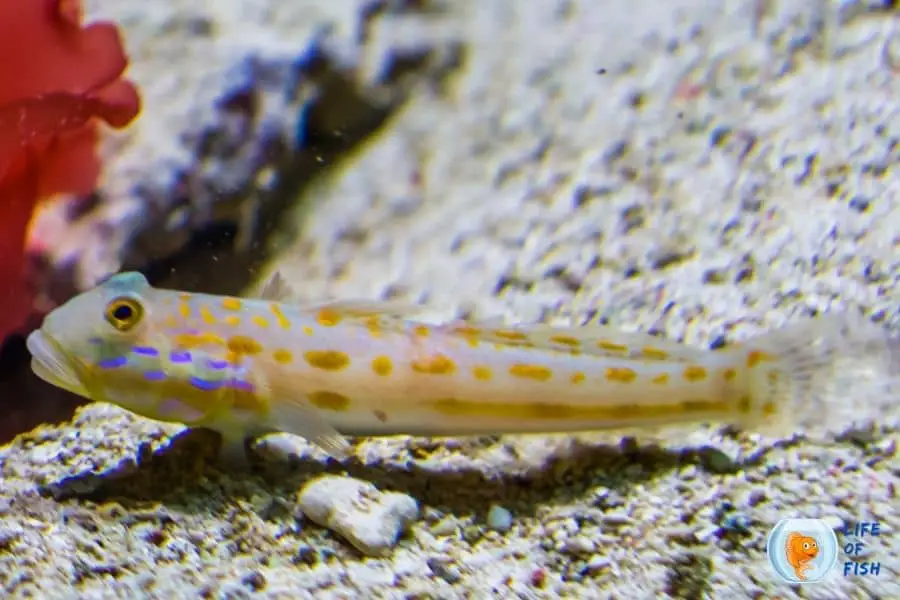
Sand Sifting Goby Types
They are the most common name. Therefore, many goby types identify under this name. But different species have different color ranges.
Diamond Goby
Scientific name: Valencienna puellaris
Diamond Goby is the most common type in the Ornamental Industry. They are also called as;
- Pretty Prawn
- Maiden Goby
- Orange spotted Sleeper Goby
- Diamond Watchman Goby
- Orange spotted Diamond Goby
- Orange Dashed Goby
Engineer Goby or Convict Goby
Scientific name: Pholidichthys leucotaenia
The juvenile stage has a black body and a horizontal white stripe. But when goby turns into adult fish, they dramatically change their body. Therefore, the adult fish have a black and yellow striping pattern.
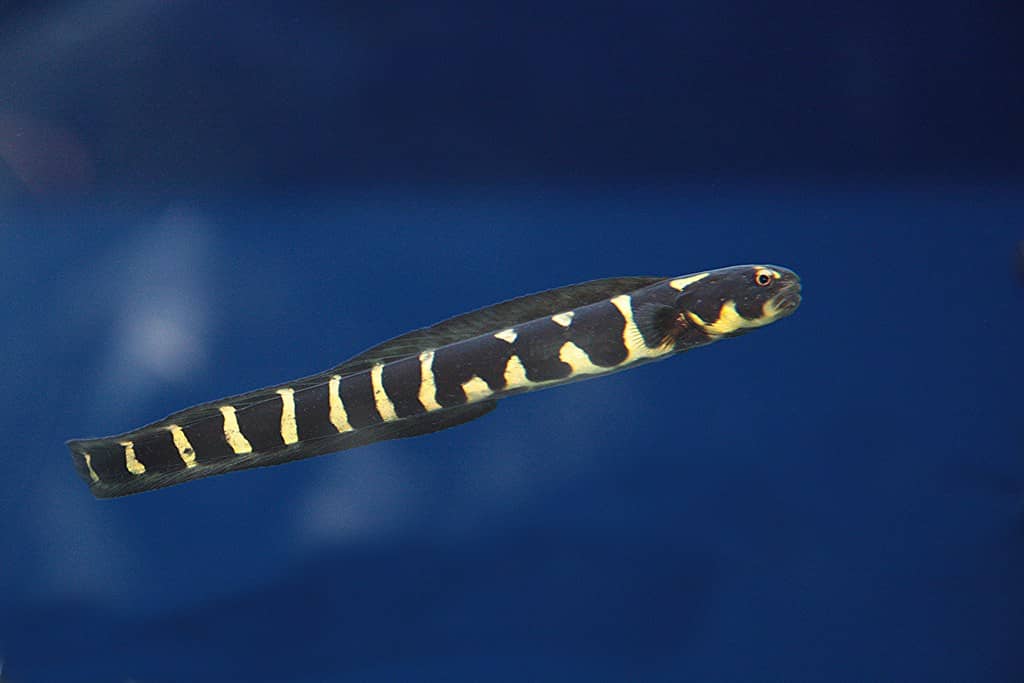
Orange Marked Goby or Spotted Prawn Goby
Scientific name: Amblygobius decussatus
This beautiful creature has bright orange markings horizontally. Those are started from the face and fade into yellow colorations and extend along their elongated body. Further, These horizontal lines are joined with vertical stripes and give a checkerboard appearance to them.
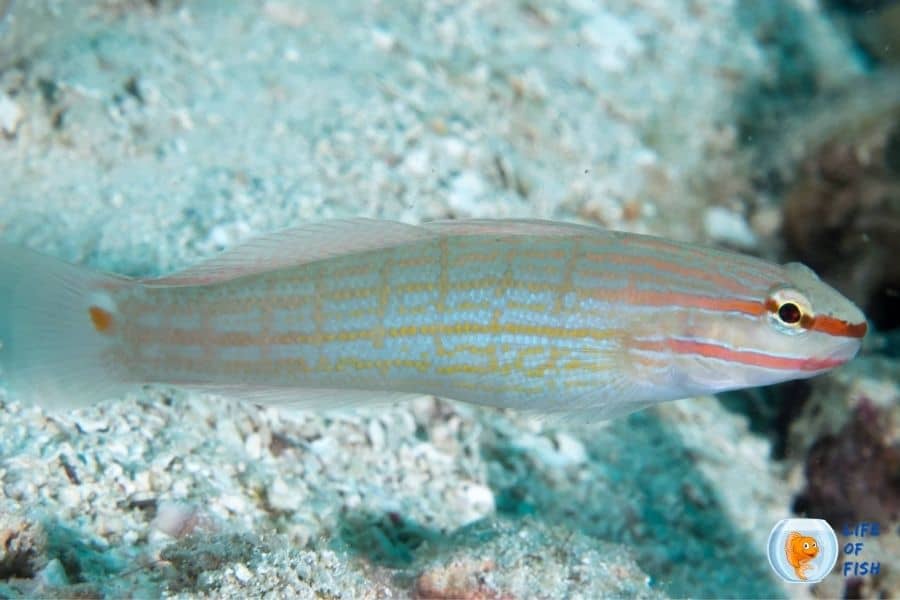
Brown Barred Goby
Scientific name: Amblygobius phalaena
The brown-banded goby is the most attractive member of the Goby family. They have a greenish-yellow head. Also, their yellow body is covered with brown bands and blue orange dots spread on the body.
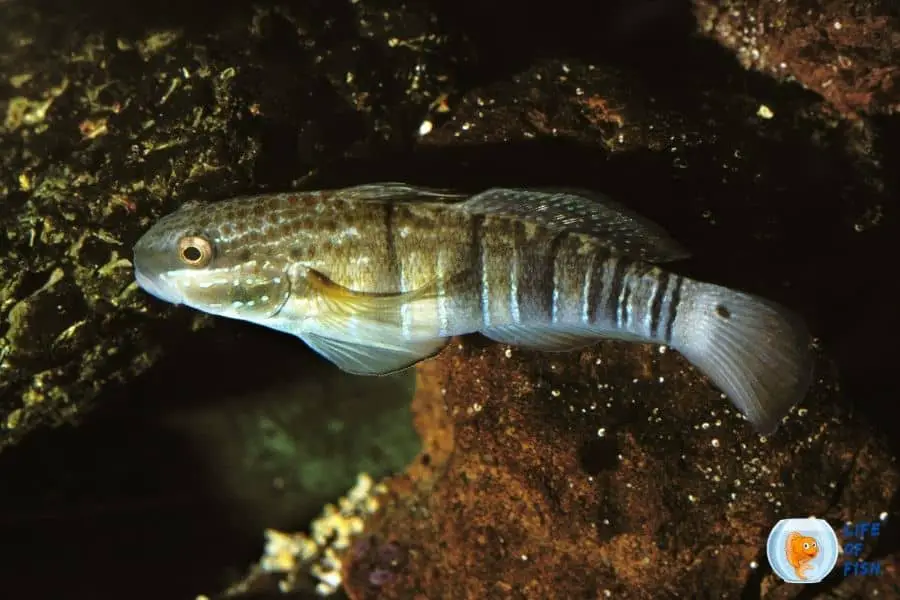
Sleeper Blue Dot Goby
Scientific name: Valenciennea sexguttata
It has a unique appearance because sleeper blue dot Goby’s whole body is white. But they have bright blue spots under their eyes.
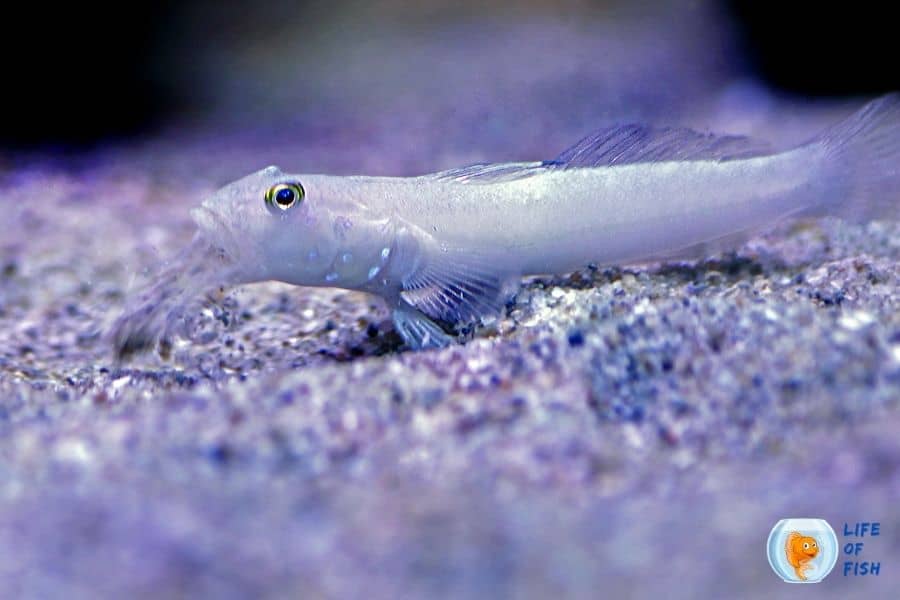
Sleeper Railway Glider Goby
Scientific name: Valenciennea helsdingeni
This sand-sifting goby variety has a silvery-white color body and two horizontal black stripes crossing their body length.
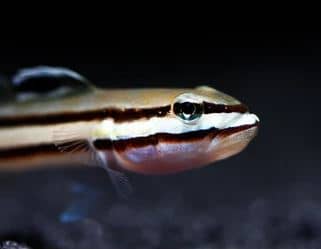
Sleeper Striped Goby
Scientific name: Valenciennea longipinnis
Sleeper striped goby’s head consists of yellow–gold, and the sapphire blue strip is situated below the eyes. Moreover, the rest of sleeper striped goby’s body is an off-white color.
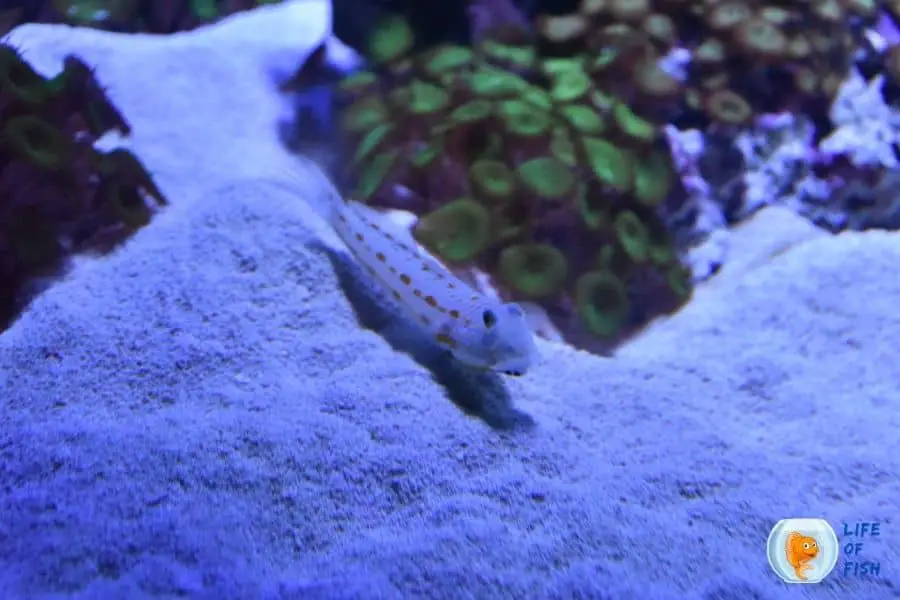
Tiger Watchman Goby
Scientific name: Valenciennea wardii
Tiger watchman goby has a white body with brown vertical bands. Further, you can see eyespots on their first dorsal fin.
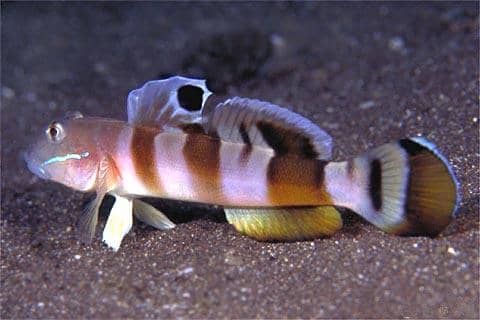
Two Spot Goby
Scientific name: Signigobius biocellatus
This species has unique and stunning color patterns. Two spots goby’s head and body are white. Further, they have orange color markings, and there are two eyespots on their dorsal fins.
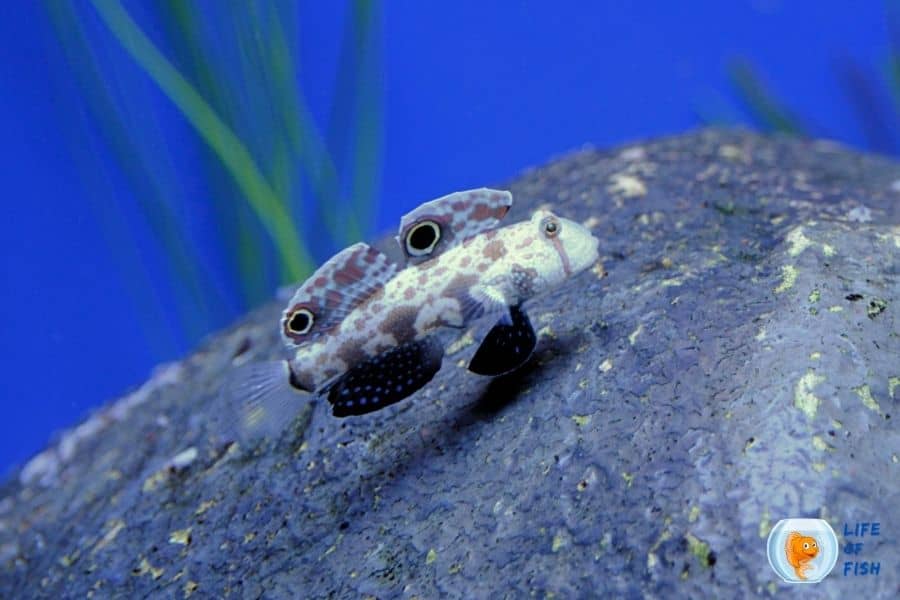
Court Jester Goby
Scientific name: Koumansetta rainfordi
Court Jester Goby has a green, blue color body and orange color horizontal stripes running the length of the body.
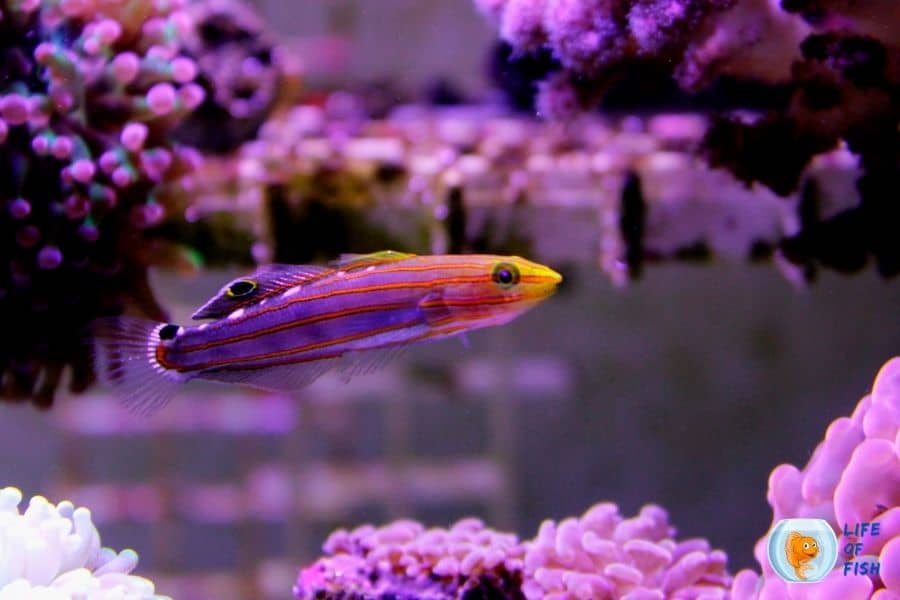
How do Big Sand-Sifting Gobies get?
Sand sifting gobies can grow up 6 to 7 inches in their natural habitat. But this estimation can vary in captivity. Hence, many factors affect the Goby fish growth. Those are Food availability, quality of the food, tank space, water quality parameters, and Tankmates. Further, if there are stressful factors in the tank, they will directly affect the growth of the fish.
The Behavior of Sand Sifting Goby
Sand sifting gobies are very active swimmers. Also, they are very good at sand sifting from the bottom sand bed. They are swimming and digging the bottom sands throughout the whole day. Goby fish take sand to their mouths and pass them through their gills. Further, they continuously swim around the live corals and sprinkle sand particles all over the corals. But it is not good for your corals. Thus, if your corals are covered with sand, they may die.
Sometimes they dig sand just near the live corals and rock formations. It causes breakdown and damage of reef structures and rock formations. Therefore, sand sifting goby is ideal for a tank that does not have live corals. Some aquarists complain that some goby fish create sand storms. So, as a result, their aquarium becomes cloudy. However, you can overcome this issue by installing a mechanical filter in your tank.
Is Sand Sifting Goby Aggressive?
Generally, Sand sifting gobies are peaceful fish. You can keep them with other reef-safe fish that are not aggressive. But Sand sifting gobies can be aggressive and territorial when you place them with the same burrowing gobies. Therefore, it is recommended to add a mated pair if you want to add two Gobies together. People can misunderstand their sand sifting activities as aggressive behavior. But it is wrong. Generally, it is the basic function of sand sifting goby.
Do Sand Sifting Gobies Bite?
Generally, sand sifting gobies do not bite their owners. Since they are very peaceful creatures, sometimes this can change due to some circumstances.
Sand Sifting Goby Lifespan
They may live around 5 to 8 years in the wild. But in captivity, sand sifting goby’s lifespan depends on your tank setup and water quality. Most fish lovers’ major question is, ‘How many years will my sand sifting goby live with me?’ The answer is, if you provide an ideal environment, your sand sifting goby will live a long time.
Sand Sifting Goby Care in Aquariums

Tank Size of Sand Sifting Goby
The minimum tank requirement is 30 gallons for single goby fish. But if you want to rear matured Goby pairs, you should have a large tank. Furthermore, they can reach six to seven inches when they get mature. These species live happily in long tanks rather than tall ones. Thus, please do not keep them in a small tank.
How Many Sand-Sifting Gobies Keep Together Per Gallon?
Sand sifting gobies show aggressive behaviors against the same species. Also, mating pairs can be together. If you have a mating pair, the minimum tank requirement is 60 gallons or more.
Tank Substrate
Carefully select the tank substrate because gobies love to sift sand beds throughout the day. Further, they burrow in the sand bed and take a rest. Sand sifting gobies do need fine sand as their substrate. Thus, the depth of the substrate should be at least three, or four inches. Moreover, the proper sand bed provides a comfortable and secure feel to the Gobies.
Important facts: If your tank has any rock formation, fix it using aquarium glue because gobies may dislodge the rock formations while digging the sand. Hence, It has the potential to injure gobies and other fishes in the tank.
Tank Setup
The tank set up should have the following equipment to grow and rare sand sifting goby healthy and happy.
- Three or four inches depth of fine Sand (Grain size 0.4 mm 1.7 mm)
- The powerhead with filter system or/and Tide maker
- Aquarium heater
- Aquarium light
The live reef formations can destruct because of Goby’s Sand burrowing behavior. Be aware of that.
Related: Garden Eel (Heterocongrinae) | Care & 11 Must-Know Facts
Related: Sohal Tang Fish Care Guide With Pictures |Must Know Points
Water Quality Condition
All Sand sifting goby varieties are marine fish. They need the saltwater aquarium to live in captivity. Additionally, you have to maintain below water quality parameters to rear healthy goby fish at the ideal level.
| Salinity | 1.023-1.025 specific gravity | Hydrometer |
| Temperature | 72 to 78 Fahrenheit | Digital Aquarium thermometer |
| pH level | 8.1-8.5 | Digital pH meter |
| Hardness | 8-12 dKH | Measuring strips |
| Ammonia, Nitrates, and Nitrite | Zero | Measuring strips |
Water Changes
The tank’s cleanliness is essential to growing healthy sand sifting gobies. Thus, change 25% of tank water at least every two weeks. Additionally, it will help the nitrates level down.
Flow Rate
In the wildWild, they live in areas that have strong ocean currents. Therefore, sand sifting goby fish prefer fairly strong currents that replicate their natural habitat conditions. You can use a powerhead or tide maker to make water currents in the tank.
Special tips: Sand sifting gobies are good jumpers. Thus, set a sealed tank roof or lid on your tank to protect your goby fish.
Sand Sifting Goby Breeding
It is possible to breed sand-sifting gobies in captivity. But you must have paired male and female gobies to perform the breeding. That’s the tricky part. The Diamond Goby is also known as protogynous fish because they can change their gender whenever they need it. In the Wild, Goby wish can breed without an opposite-sex fish.
Sand Sifting Goby Male vs Female Differences
The male and female sand sifting gobies have identical appearances. Thus, it is difficult to distinguish between male and female gobies clearly. You can identify them by observing the shape of the fish’s genital papillae. It is the protruding structure situated near the anus. The male sand sifting goby has a pointed tube just after the anus. But females have round-shaped genital papillae. Additionally, in the spawning period, male fish guard the nest while eggs are developing. You can identify male gobies by observing their appearance too.
How to Breed Sand Sifting Goby?
- Firstly, place one male with three female sand sifting gobies
- In the spawning period, female goby lay their eggs in the cavity of the coral or rock formation
- Then, the male sand sifting goby fish fertilize those eggs
- After that, the male sand sifting goby guard the eggs until they hatch
- Eggs hatch within a few days and fry fish are emerges
- Then, Remove larvae from the main tank
- If not, they will be prey for another species
- Further, you need to provide plenty of quality food as a fry diet
- Fry prefers a live planktonic diet
Note: Sand sifting goby fish lay around 30-40 eggs per spawn. You can remove those eggs from the main aquarium and place them in a separate tank.
Further, keep in mind to give good aeration until the eggs hatch. After eggs are hatched, reduce the aeration rate of the tank.
How Many Babies Do Sand Sifting Gobies Have?
The larvae survival rate depends on your care. So, keep your eye on the eggs. Please give ideal water quality parameters for eggs. The ideal water quality parameters are mentioned in the above table.
How to Care Sand Sifting Goby Fry?
It would be best if you gave optimum water quality conditions to rear goby fry fish. Further, a balanced diet is playing a major role. Live planktons are the best larvae feed, and you can purchase them from a pet store. Continuously give plankton food until they can eat other formulated feeds.
Related: Sebae Anemone | Beginners To Expert Care Guide |
Related: Cleaner Wrasse | Definitive Care Guide |
Also see: Stomatella Snail A Good Addition To Your Reef Aquarium
How To Feed Sand Sifting Goby?
Sand sifting goby is a carnivore. Therefore, they eat meaty matters only. Thus, you should pay attention to it when selecting food for goby. Feeding gobies is an interesting thing. Most of the live feed disappears in the sand bed. Then the gobies spend much of their day searching for that food by shifting sand. Also, they try to hunt the species that hide in the sand substrate. So, they take sand to their mouth and filter through their gills. If sand contains some tiny foods such as invertebrates, the goby fish extract them.
What Do Sand Sifting Gobies Do In The Wild?
In the wild, they have interesting feeding behavior. Sand sifting gobies suck fine sands through their mouths and expel sand out from their gills. While sucking sand, they take small live creatures as their food.
What To Feed Sand Sifting Goby In The Aquarium?
You can provide meaty foods for your Goby fish. Additionally, most aquarists use the following foods to feed their sand sifting goby. But it is recommended to use live, frozen, or formulated meaty foods to keep your fish happy and healthy.
Live diets
- Brine shrimp/ artemia
- Krill
- Mysis
- Copepods
Prepared food
- Mini sinking pellets
- Flake foods
When To Feed Sand Sifting Goby?
You can adjust feeding time according to your work. Feeding time is not a huge matter. But it would help if you tried to add foods at the same time every day. For example, if you add food at 9.00 O’clock, 1.00 O’clock, and 7.00 O’clock, try to maintain that routine every day. After fish adjust to your routine, they seek food in that certain period. So, do not disappoint them.
How Much To Feed Sand Sifting Goby?
Add a small amount of feed at once. It would be best if you fed sand sifting goby twice or three times per day. Make sure that your sand sifting goby gets an adequate share of food. Do not overfeed Goby fish. Because overfeeding can cause some health problems. Also, excess feed spoils the water quality of the tank.
Tankmates for sand sifting goby in an aquarium?
Sand sifting gobies are adding a vibrant look to your aquarium. They are peaceful creatures and can live with reef-safe fish that are not aggressive. To enhance the attractiveness of your tank, you should add saltwater species with gobies that have different colors, such as;
- Clownfish
- Dwarf Angelfish
- Damsels
- Cleaner Wrasse
- Shrimps
- Filefish
- Pink Fairy Wrasse
- Fox face Rabbitfish
But sand sifting gobies are aggressive and territorial when they place with other burrowing gobies. Because of this reason, add a single goby or mated goby pair to the same tank to reduce their aggressive behaviors.
Will Sand Sifting Gobies Eat Cleaner Shrimp?
No. Gobies are peaceful creatures. They can co-exist with cleaner shrimp peacefully. However, the cleaner shrimp may clean Gobies’ bodies too. Do not fear it.
Sand Sifting Goby Predators
Sand sifting gobies are a carnivore, and they are at the highest level of the food chain. Therefore, they do not have huge predatory stress. Anyhow, humans become a major predator of Sand sifting goby fish because humans tend to catch them to sell in the ornamental industry.
Sand Sifting Goby Facts
Sand sifting goby can find food by sifting the bottom sand bed. Further, they can change their gender if the opposite gender fish is not present in the spawning period. In the wild, they will grow around 6, or 7 inches. But in captivity, they can grow around 4, or 5 inches. Moreover, sand sifting gobies can mess up your aquarium with sand. Thus, live coral can be badly affected by its activities.
Related Questions
Is Sand Sifting Goby Eat Plants?
No, sand-sifting gobies do not eat the plant. They are a carnivore fish variety. In the wild, they mainly rely on live foods. In the aquarium, they like to eat live foods, frozen and formulated food consisting of meaty substances.
How Much Is A Sand-Sifting Goby Worth?
Several saltwater Goby varieties are used as pets. According to the variety and size, their price will vary.
| Common name | Price |
|---|---|
| Diamond Goby | $30 – $35 |
| Engineer Goby | $14 – $22 |
| Orange marked Goby | $19 – $24 |
| Sleeper Banded Goby | $35 – $58 |
| Sleeper Railway Glider Goby | $ 50 – $60 |
| Sleeper Striped Goby | $26 – $70 |
| Tiger Watchman Goby | $ 45 -$ 50 |
| Two Spot Goby | $ 28 -$40 |
| Court Jester Goby | $ 30 – $35 |
How To Catch A Sand Sifting Goby?
You can use a fish trap to catch sand sifting goby easily. First, you should add frozen food inside the trap and wait until goby fish go into the trap. Be patient while catching them. Sometimes you have to wait for a couple of days to catch Gobies without disturbing live coral reef structures.
Also Read : Moon Jellyfish Care Guide | Everything To Know | Exotic Pets
